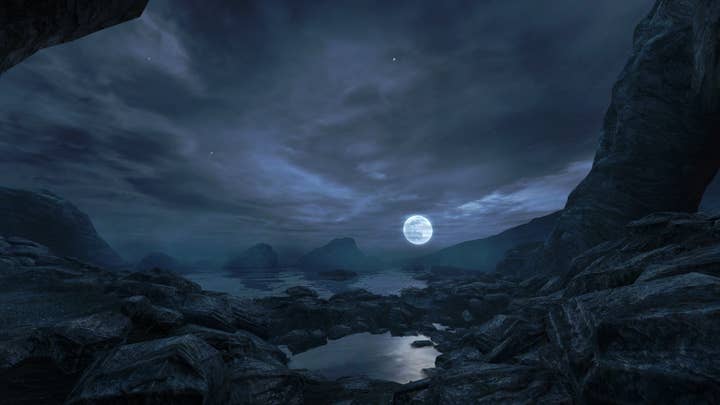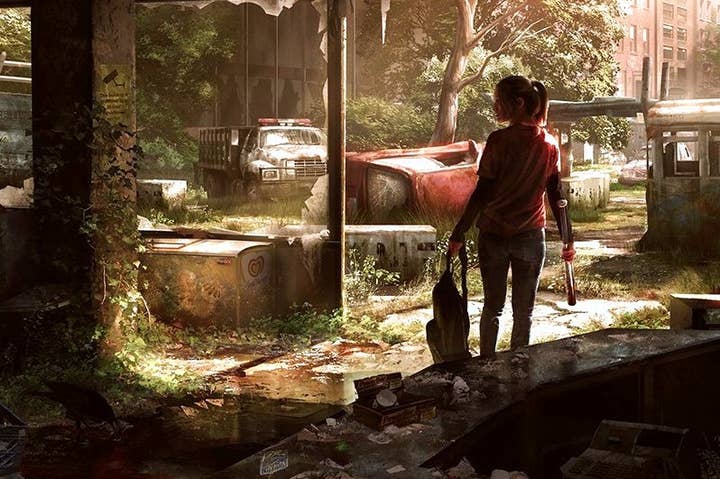Next Gen Art Event: Putting games in galleries
A new spin on the question of 'are games art?'
It feels at once natural and bizarre to see Thatgamecompany's Flower on display in a prestigious art gallery. Natural because its beautiful, unconventional design has long made it the worthy poster child of the 'art game' movement; bizarre because, unfortunately, it's still so rare for curators of art to take notice of video games at all, let alone to give one such pride of place.
At the Fries Museum in Leeuwarden, The Netherlands, such prejudices seem to have been dispelled. Their New Horizons exhibition celebrates the power of the virtual landscape, displaying videos, concept drawings and promotional pieces from a variety of video games alongside the work of prominent artists such as Jennifer Steinbeck, Harun Farocki and Cory Arcangel.
The exhibition finds wonder in even the most seemingly mainstream and consumer-focused of games, encouraging visitors to view them in a new light. Screenshot prints of the multiplayer maps of Battlefield 4, with all soldiers and action absent, are strangely haunting and affecting when taken out of their usual context. The reality-bending gameplay of Portal seems that much more thoughtful when shown alongside the influential impossible spaces of M.C. Escher.
It's one of two exhibitions held as part of the new annual Next Gen Art Event, which also features talks and workshops by leading developers. It's a celebration of art in video games, and video games as art.
Leeuwarden, capital city of the Friesland province of The Netherlands, makes for a wonderful setting, with its winding canals and impressive architecture. In 2018 it will be one of the EU's European Capitals of Culture, having won the honour in 2013 despite competition from its more populous and influential neighbours. The title has already brought extra funding for the arts, allowing for the creation of new events such as the NGAE.

For the inaugural event in November 2014, an encouraging number of studios contribute their work. The second exhibition, more publicly visible as a large installation in a nearby shopping mall, features art from sources as diverse as Irrational Games, Oddworld Inhabitants and Capcom. Many pieces were printed especially for the show, and advanced printing techniques (including several works reproduced, remarkably, on solid aluminium panels) bring them to eye-poppingly vibrant life. A stand-out feature of the exhibition is 'The Art of Naughty Dog', a touring collection celebrating the studio's 30 years in the industry - at one end, the bleak landscapes of The Last Of Us, at the other the cheesy grin of Crash Bandicoot.
"One thing we've always talked about at BioWare is how to get concept art and environmental art in a gallery," says Derek Watts, art director for the Mass Effect franchise, standing next to an impressive lithograph of fan-favourite character Garrus. He's one of the speakers at the event, giving talks on the process of creating iconic series protagonist Commander Shepard.
He's joined by Mike Lester, systems engineer at Thatgamecompany, speaking about the balance in games of art and tech, and Naughty Dog concept artists John Sweeney and Nick Gindraux, explaining their respective methods and the sometimes surprising details of modern digital painting. Their audiences consist largely of Dutch students eager to enter the games industry, whose infectious enthusiasm makes it clear that these established developers are their rock stars. The Q&A sessions stretch past their scheduled time as the amount of eager hands in the air seems to grow rather than shrink. They eventually end, but the questions don't - attendees form a line to talk to the speakers one-on-one, asking for more personalised advice. This is the next generation of games developers, and they're wearing their passion for video game art firmly on their sleeves. They certainly take it seriously, and there's a palpable sense of excitement that the NGAE takes it seriously too.
Lester even manages to gather a spontaneous entourage of European indie developers, including members of Team Reptile, the studio behind surprise hits Megabyte Punch and Lethal League. One man, an artist for Skylanders Trap Team developers Beenox, has travelled across the border from Belgium to attend.
""The Netherlands isn't known for having a particularly large game dev community, and I like the idea of starting at the student level to help get it going"
I ask Lester what made him want to participate in the event. "The students, and the location," he answers. "The Netherlands isn't known for having a particularly large game dev community, and I like the idea of starting at the student level to help get it going."
Did he feel, with his talk, that he'd contributed to that goal?
"I liked being able to connect with the students," he says. "I feel like they really heard my message."
A unique feature of the event is undoubtedly a dinner held for guests and press at local Michelin-star restaurant Eindeloos. Each course is hand-crafted by the head chef in tribute to each of the speakers' games - a starter including edible flowers representing Flower, for Lester; a diverse selection of mushrooms evoking the 'Clicker' enemies of The Last Of Us for Sweeney and Gindraux; and a course sculpted and arranged to resemble the architecture of Mass Effect, for Derek Watts. Quite possibly the first ever instance of games as art as food.
The event as a whole feels like a rarity, as much for its approach as for its content. It's easy for those within the industry to internalise outside attitudes towards gaming, to accept the narrative that games are an inherently inferior form of art. At the NGAE, games are given absolutely equal footing. To a significant degree that's due to organisers Tim Laning and Maarten Brands.

Laning is a developer and a co-owner at Grendel Games, a local studio specialising in what he dubs 'serious games', games with important medical, rehabilitative or educational functions. His work includes Gryphon Rider, for Kinect, designed to help children whose balance has become impaired due to serious illnesses or disorders, and OmNomNom, which aims to fight childhood obesity. It's natural, then, that he would see huge cultural value in video games as a whole.
"Pre-production art and in-game art never get the exposure they deserve outside of their context, besides the occasional special edition art booklet," says Laning. "I decided it was time to organize an event that celebrates the ideas, creativity and image quality of video game art and how that relates to modern- and established art."
Brands is CEO of Cook & Becker, a company specialising in selling high quality prints of video game art. Many of the pieces on display were printed under the direction of him and his team, and a reverence for video game art is core to his business.
"We founded the company especially with the idea that artists and studios in the games industry play such a big part in shaping our visual culture that they should have a more prominent position within the wider contemporary art world"
"We founded the company especially with the idea that artists and studios in the games industry play such a big part in shaping our visual culture that they should have a more prominent position within the wider contemporary art world," explains Brands. "That means taking game art more seriously, chasing iconic designs from our industry and showcasing it at art fairs,museums, wherever we can."
Events like this will find it difficult to gain traction, however, unless the industry gets behind them. There's a feeling, among the organisers, speakers and attendees I talk to, that publishers and developers bear a new responsibility to support efforts like these.
"As long as the general public has the perception that game art only consists of elves, scantily clad female assassins and space marines instead of architecture, unique landscapes and a deep appreciation of colour, lighting and shape design, it won't receive that serious appreciation on a wider scale," says Laning.
"We need to continue to organize and promote more events like this one," agrees Watts. "It's up to the video game industry to present games as serious art."








